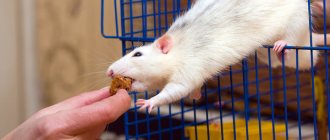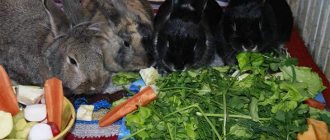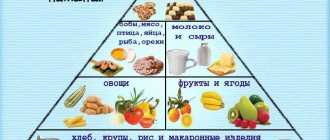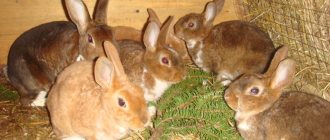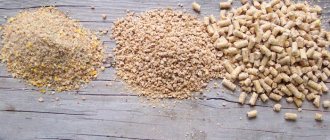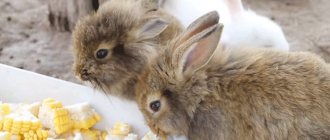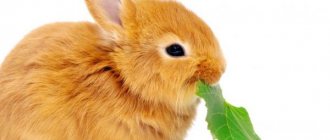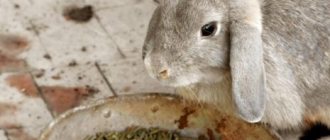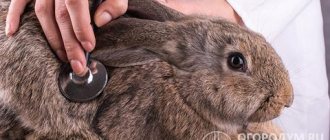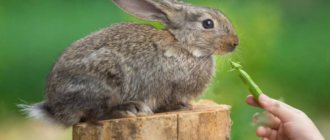Feeding
4670
no comments
Oats are the standard food for granivores. Due to its high energy value, it is widely used for fattening rabbits. On the other hand, the input rate is reduced for adult animals; they do not need excess energy; vitamins and minerals of succulent feed and feed additives are more important. Before feeding, oats are crushed, ground, steamed, and yeasted.
Photo. You can't do without grain when fattening rabbits
Is it possible to give rabbits vetch with oats?
Rabbits are one of the most finicky farm animals when it comes to nutrition.
Certain herbs, grains or vegetables can cause disturbances in the digestive system in animals, lead to obesity, and also cause intoxication of the body, therefore, when creating a menu, it is very important to take into account the characteristics of each product and the nuances of serving it to rabbits. Oats are considered one of the most favorite grains for animals.
How to feed it correctly and in what form, let's figure it out.
Is it possible to feed rabbits oats?
Oats are concentrated feeds that rabbits need for full, proper development and growth. Its benefit lies in the fact that it contains a huge range of nutritional components that have a beneficial effect on the health of animals, and has a high energy value of 336 kcal/100 g. The cereal is enriched with the following minerals:
- zinc: takes part in enzymatic reactions, increases the body’s protective qualities, prevents damage by viruses and infections;
- silicon: responsible for the condition of tissues and organs, plays an important role in carbohydrate, protein and fat processes, ensures the strength and elasticity of the skin;
- magnesium: has a positive effect on the functioning of the cardiovascular system, supports the functioning of the adrenal glands, increases the body’s resistance to stress and nervous tension;
- copper: actively participates in the processes of growth and further development of tissues, is responsible for the full functioning of the immune system.
It also contains a number of biologically active substances:
- B vitamins (B1, B5, B6): normalize metabolic processes, improve the functioning of the reproductive system, and normalize the nervous system;
- vitamin A: strengthens the immune system, increases the body's protective functions, prevents the risk of developing various diseases;
- vitamin E: normalizes the function of the reproductive system, regulates mineral, fat and carbohydrate metabolism;
- Vitamin F: necessary for the construction of cell membranes, increases the absorption of other vitamins.
The cereal contains an increased amount of carbohydrates - 55%, proteins - 10% and fats - 8%. However, most of all, oats contain pantothenic acid, which actively participates in metabolic processes, improves food digestion and, due to antioxidants, cleanses the body and removes harmful substances.
Rabbits are excellent at eating cereal in dry, sprouted, steamed form or mixed with other grains. Moreover, if other cereals need to be steamed, crushed or crushed before serving, then soft oats are excellent for dry feeding, and rabbits will be able to eat them freely.
It is allowed to feed animals with green oats, which are picked in the early stages of ripening.
How to give dry oats to rabbits
Two-thirds of a rabbit's diet should consist of foods with high nutritional value, namely grains.
It is especially important to provide animals with such nutrition in winter.
The best option for both adults and young animals is oats, which the animals eat with great pleasure.
To create a balanced diet, experts recommend not stopping at just one grain, but preparing grain mixtures from wheat, barley, corn and bran. The ratio of grains in mixtures will depend on the age and breed of rabbits:
- young animals during the period of active growth: oats - 30%, wheat - 10%, barley - 15%, corn - 30%, bran - 15%;
- adults: oats - 40%, wheat - 20%, barley - 20%, corn - 10%, bran - 10%;
- meat animals: oats - 15%, wheat - 20%, barley - 40%, corn - 15%, bran - 10%.
Oats should be introduced into the diet of rabbits as soon as they begin to feed on their own. It is better to start feeding with steamed cereal, which is easier and safer for a small organism to digest. Gradually, animals are accustomed to crushed food, and starting from the age of six months, they switch to whole grain. Baby rabbits are fed cereals up to 4-5 times a day, adults - up to 3 times.
Germination
The value of sprouted grain is that “blocked” nutrients and enzymes that do not penetrate the rabbit’s body when consuming dry food are released and absorbed completely. Swollen fiber cleanses the animal’s intestines well, removing waste products and strengthening the immune system.
How to germinate oats correctly?
- For germination, clean grains no more than one and a half centimeters long are selected. Long oat seeds are poorer in composition, spoil quickly and release toxins.
- If there are not many rabbits on the farm, just take a plate or put the cereal in a cloth and wet it. Constantly maintaining humidity, wait for the seeds to germinate.
- On a large farm, grain is sprouted in buckets; for this, the oats are filled with water so that it rises 2 cm above it.
- After 12 hours, the seed will swell; it is transferred to plastic bags with holes at the bottom; there is no need to tie them tightly. Holes are necessary to drain excess moisture.
- The bags are placed in a warm place. To prevent the grain from going rancid, shake the bags periodically; the layer should not exceed 8 cm.
- If the mixture has darkened, it is no longer suitable for use.
- When sprouts appear, the vitamin food is ready. You should not give it too much at once, it will cause bloating. Sprouted grains should be introduced into the diet gradually.
- When adding sprouted oats to the mash, do not grind it in a meat grinder. When in contact with iron, enzymes are destroyed.
Main components of grain mixtures. Corn.
Advantages.
- Balanced composition (optimal growth and maintenance of reproductive functions).
- Convenience of feeding. Only water granules.
- Ease of transportation and storage.
- Availability of growth accelerators (proteins, premixes, yeast, vitamins)
- Stable diet and absence of digestive disorders.
- Minimal risk of harmful inclusions.
- Easily eaten, little waste.
- Does not lead to obesity in breeding individuals.
- Gradation of compound feeds according to different categories (for young animals, for adults, for lactating animals, fattening)
- Possibility to contact the manufacturer to clarify current issues.
Flaws.
- Expensive.
- Not sold everywhere, rural areas are especially affected.
- Possible counterfeit.
- Possible addition of substandard components (mucoid enteritis).
- Habituation of rabbits and associated risks of disorders when changing brands or batches of food.
- You need several types of feed for different categories of rabbits.
Advantages.
- Cheaper than feed, especially in rural areas.
- Availability of purchase.
- Natural, natural taste of meat.
- Visual control of the composition.
- The ability to change the composition of the mixture yourself for different categories of rabbits.
Flaws.
- Growth is slower than when fed with compound feed.
- The need to grind grain (corn, wheat) for small rabbits.
- The need to prepare and store hay.
- The need to steam the crushed grain mixture.
- Risks of grain contamination on threshing floors.
- Large losses due to trampling.
Barley is considered the most versatile. Thanks to a unique set of nutritional components, it is suitable for all categories of rabbits: babies and adults, pregnant and lactating females. If you feed only one grain, then it is best to stop at barley. It is eaten with great appetite and does not create digestive problems even with constant access to food.
Wheat is just as versatile, even more high in calories. Although this may be a disadvantage. More precisely, rabbits, when fed uncontrolledly, overeat and gain fat. For fatteners it may not be bad, but for others it’s a big problem with reproduction. In addition, overeating wheat grains can cause bloating.
Oats, as the opposite of wheat, are easily digested, improve digestion, and do not cause obesity. Very useful for breeding rabbits, increasing reproductive functions. However, it is inferior in calorie content. For the normal development of the animals, it is necessary to mix other grains with barley or alternate with it.
Peas are rich in proteins and fats, but are difficult to digest. Under-dried beans can cause upset. But, if given correctly, the benefits are enormous. Indicated for females, as it improves lactation (milk production) and supplies building material for the formation of embryos. The young animals are gaining weight well. It is best to steam crushed peas (as part of a grain mixture, mash, or even separately).
Pearl barley
This grain is especially useful for obtaining high quality wool. Pearl barley contains the following beneficial substances:
- Vitamins A, E, K, as well as group B.
- Macroelements: magnesium, potassium, sodium, phosphorus, calcium.
- Microelements: zinc, iron, manganese, copper, selenium.
You can prepare mash based on pearl barley, which will account for almost half.
Adults are given 80 grams per day, during the period when mating is planned - 95 grams, and females during pregnancy - 85 grams. Pearl barley is part of a rabbit food mixture that can be purchased at pet stores.
This cereal is one of the important components of the diet of rabbits that are fattened to obtain a large amount of dietary meat. It is better to offer oats to rabbits in a mixture with other cereal products.
Oats are a high-energy grain feed. Oats contain a large amount of water-soluble and fat-soluble vitamins. If you feed oats in dry form, it is recommended to first crush them into small pieces using a grain crusher.
You can also steam the oats before feeding. To do this, add boiling water to the mixture consisting of oats and other grains so that the water covers the cereal, and leave to stand overnight.
In the morning, you can offer the rabbits the steamed mixture. Another way is to add yeast dough to wet oats. It is necessary to ensure that there is no mold, which gives the food an unpleasant bitter taste, which can lead to rabbits refusing such food.
In what form to give
Each owner decides for himself in what form to give grain to his pets. In any case, the ingredients must be carefully inspected and all spoiled grains must be removed. The feed may be unusable due to fungal or insect damage. Rabbits should not be given unripe, raw or overdried grains. High-quality raw materials for feed mixtures are processed in different ways.
Yeasting
The feed preparation method is often used for fattening meat breeds of rabbits. This kind of “doping” whets the pet’s appetite and helps the animal gain weight. Feed preparation consists of several stages:
- The raw materials are crushed and filled with clean water. The optimal proportions are 1:2.
- 35 g of yeast are diluted in 2 liters of warm water.
- The prepared ingredients are mixed and left to ferment overnight.
- After 8-9 hours the nutrient mixture will be ready. During infusion, the mass is stirred periodically.
3 tablespoons of the resulting yeast mixture are added to the feeder, diluting the dry grain mass intended for feeding.
Steaming cereals
A favorite, simple method of preparing nutritious food for long-eared pets. Selected grains are placed in a bucket. You should not fill the container completely, the steamed raw materials will increase in size and the mass will “overflow its banks.” The grain is poured with boiling water, 1 tbsp is added to the mixture. l. salt and leave for 5-6 hours. The swollen mass of sweet grains is fed to animals.
How does a hare differ from a rabbit, comparison of species and is crossbreeding possible? Read
Germination
Sprouted grain helps cleanse the intestines and improves the immunity of pets. Unlike dry raw materials, sprouted cereals and grains are completely digestible by animals.
The feed mixture is prepared as follows: dry grains are poured with warm water and left to swell for 24 hours. After soaking, the raw materials are laid out in baking trays. Then the grains are covered with a piece of damp gauze and left until germination. When the first green beaks of the sprouts appear, the food is ready to eat.
Crushed grain
Oats, wheat, corn or barley are crushed and given to animals in this form. This mixture is easy to find on sale or make yourself.
» width=”600″ height=”291″ data-srcset=”https://dachamechty.ru/wp-content/uploads/2020/04/krolik-zerno-trava_02.jpg 600w, https://dachamechty.ru /wp-content/uploads/2020/04/krolik-zerno-trava_02-300×146.jpg 300w" data-sizes="(max-width: 600px) 100vw, 600px">
How to choose grain for germination and prepare food
Sprouted grains, especially wheat and oats, are considered an excellent addition to a rabbit's diet, containing large amounts of vitamins and beneficial enzymes. When choosing a culture, you need to pay attention to the following criteria:
- Quality of the composition. If there are weed seeds or pebbles among the grains of wheat or oats, it is better not to purchase it.
- Ripeness of culture. When there are a lot of green, unripe grains in the mass, such food will not be beneficial to rabbits.
- No mold or pests. The grain needs to be carefully reviewed; if there are particles with black spots, you should refuse such a purchase.
- Cereal quality. The grain must be in good condition; feed cannot be prepared from raw or overdried grain.
- Shelf life. If the grain has been stored for more than 1 year, the grains will not be able to germinate well.
For germination, the grain is spread in a thin layer and moistened.
To germinate grains and prepare high-quality food, you need to do the following:
- Rinse the grain thoroughly in plenty of running water.
- Soak wheat or oats in water and place in a warm room for a day.
- Remove grains that have floated to the surface from the total mass.
- Spread the mixture in an even layer on a wide, flat dish, such as a baking sheet or tray.
- Cover the grains with moistened gauze and place in a warm place for germination. In a few days the food will be ready to eat.
Important! You should not prepare a lot of sprouted grain at once, since as the stalks grow, the usefulness of such complementary food decreases.
Preparation of grain mixture
Feed mixtures for the breeder will be convenient because their composition can be varied at your discretion, adapting to the specific needs of the animals, taking into account seasonality, health status and breed. Grain mixtures can be made from dry crops or you can prepare balanced food for rabbits by choosing one of the options for preparing grain. In addition to the main grains, it is also allowed to include bran or seeds in the grain mixture.
It is recommended to mix oats with barley to avoid unwanted buildup of internal fat in rabbits
When preparing feed, the age group of the animals should also be taken into account. For young rabbits, the feed mixture should contain at least 50% wheat, the rest will be barley and corn
The optimal composition of the feed mixture for adults will be:
- oats – 50%;
- corn – 20%;
- wheat – 20%;
- barley – 10%.
How to give
Feeding a rabbit grain has its own secrets; proper preparation of grains before feeding them to animals will help increase the nutritional value of the food. Processing will improve digestion and absorption of substances, enrich the composition of the feed and increase weight gain.
Some rabbit breeders prefer to feed the crops dry, without grinding the grain. But this approach does not justify itself: the nutritional value and digestibility of the feed are low, which leads to increased product consumption.
- For example, barley and corn will be digested more fully if they are crushed and steamed.
- Soft wheat and oats are suitable for dry feeding in their pure form; it is easy for rabbits to chew them.
- Cereals are sprouted as a treat and vitamin supplement.
- It is preferable to use corn in combination with other feeds that have a high content of protein and amino acids. Therefore, you need to add peas or beans, clover and cake.
- When it is difficult to purchase grain on your own, ready-made feed is used for home feeding. The main thing is to ensure proper storage to prevent dampness and mold development. If everything is done correctly, the animals on the farm will be healthy.
- Corn is not crushed for future use: it contains a lot of fat, so the crushed grain quickly burns out. The optimal storage method is in dry cobs.
What do they feed?
To raise healthy livestock, you need to provide your pets with enough important nutrients. Due to their rapid reproduction and rapid growth, long-eared animals require a special approach to menu planning. Any mistake by the livestock breeder will immediately manifest itself in diseases and mass mortality.
Why shouldn't you feed your animals with professional feed? It is difficult for beginners to choose their favorite diets for animals the first time, based on their physical condition and the characteristics of their keeping. You need to search for the menu experimentally, and this takes a significant toll on your pocket.
What grain to feed rabbits? Cereals are an ideal option that saturates the body with the necessary energy and is liked by the livestock. They contain a sufficient amount of fats, proteins and carbohydrates, so the food will be relevant during the cold period. Steamed grain is given to young broods, and adults can be given dry grain.
Using only greens and vegetables in your diet, it is difficult to achieve weight gain. Because of this, animals lose weight, which affects the quality of the final product. Food is not only a complete menu, but also the prevention of gastrointestinal diseases. Experts know that cereals are quickly and easily digested by animals.
The popularity of grain crops is also associated with accessibility. Unlike expensive professional food, their price is affordable, and you can purchase them both in a pet store and from hand. You need to find a trusted supplier who values its reputation and will not offer low-quality goods.
Corn and wheat grain must pass inspection. And if the quality is confirmed, you can safely make mixtures from such products for feeding furry little ears. The rabbit will happily consume steamed grain, if it is a concentrated feed, throughout its life.
Is it possible to give pearl barley to rabbits: or why do you need an accordion for your butt?
Pearl barley can certainly be given to rabbits. Idiomatic expressions in Russian such as why does a goat need an accordion, why does a goat need an accordion, are widely used in colloquial speech. Idioms express the meaninglessness of any action. In this case, the irony is expressed about feeding rabbits with a relatively expensive food product. Pearl barley is barley, a product purified from films and other useful surface parts of the grain. Why then is it considered that giving pearl barley to rabbits is just not reasonable?
Photo. Pearl barley can be fed to rabbits
What should not be in the diet: prohibited foods
Due to their undeveloped stomach muscles and very long intestines, rabbits must always be provided with sufficient food. Each new portion of food pushes what was previously eaten through the intestines. To avoid stagnation, the rabbit must constantly eat something. However, it is also impossible to overfeed animals, and if there is often food left in the feeders, then the amount of food consumed should be reduced.
Not all grass is good for rabbits.
Rabbits have a very fast metabolism, so they eat a lot. But not every food is healthy. There are some foods that can be extremely dangerous for them. So what should you not feed rabbits? Let's try to figure it out.
Vegetables and fruits
Rabbits love succulent food, which includes vegetables and fruits. But they should not make up more than a third of the total daily diet. An excess of such feed can lead to bloating, disruption of the stomach and intestines, and in some cases, the death of the animal.
Be careful when feeding rabbits dried vegetables in winter. They swell in the stomach, which can lead to intestinal blockage.
Do not give boiled, fried or stewed vegetables to rabbits.
Read also: Fertilizing and feeding carrots in open ground
Attention! It is strictly forbidden to feed rabbits tomatoes, fresh red beets (with the exception of tops), new potatoes, onions, eggplants and red cabbage. As for fruits, the choice is small
Rabbits can only be offered dried apples and pears, in small quantities and not often. Moreover, it is better to dry them yourself, after removing the core. Under no circumstances should rabbits be fed any exotic fruits.
As for fruits, the choice is small. Rabbits can only be offered dried apples and pears, in small quantities and not often. Moreover, it is better to dry them yourself, after removing the core. Under no circumstances should rabbits be fed any exotic fruits.
You should not give fresh berries to rabbits, they cause fermentation in the intestines.
Branches that are so necessary for healthy teeth and stomach must also be chosen with care. Animals should not be given branches of wild rosemary, apricot, bird cherry, wolf's bast and elderberry.
Limit the consumption of cherry and cherry branches.
Poisonous and dangerous plants:
horse sorrel; aconite; quinoa; spurge; Melissa; wild radish; digitalis; lily of the valley; marsh horsetail; buttercup; sleep-grass; celandine; henbane; nightshade; hellebore; hemlock; lumbago; dope.
Attention! Even a small amount of these plants can cause vomiting, diarrhea, shortness of breath, arrhythmia, bloating, seizures and death in a rabbit. They are especially dangerous for pregnant females and young rabbits
Poisonous plants lead to the rapid and painful death of the animal.
Milk products
Contrary to popular belief that milk protein is good for animals, this is not the case with rabbits. Only suckling babies need milk before and after vaccination. And for adult rabbits, milk, sour cream, cottage cheese and cheese are prohibited. Protein deficiency can be easily compensated with barley and dry yellow peas (in small quantities).
Legumes and grains
A significant part of a rabbit's diet consists of grain crops, and a slightly smaller portion of legumes. Under no circumstances should you give rice, sunflower seeds, millet, millet and rye. They will not bring any benefit. This is a very solid food containing little fibre. If rabbits eat little hay, which is placed in a cage (you can easily make one yourself), then it is good to add a small amount of bran to the food.
Hay should not contain many legumes.
From legumes you will have to exclude beans (red and black), beans and young peas. Such food is fraught with bloating and indigestion. Never give rabbits ready-made sweet cereals with milk and pea puree.
Sweets and baked goods
Sweet crackers, crackers, cookies, white bread, etc. are dangerous to the health of rabbits (regular and decorative). Furry pets can occasionally be pampered with special dry treats. For ordinary rabbits they are also prohibited. Excess salt, sugar and fat in food can lead to dire consequences.
The menu of decorative rabbits is not too different from the usual diet of meat rabbits. The list of prohibited foods can be supplemented with nuts, chips, ice cream, candy, sausage or meat and any cereal flakes. These products, which are extremely dangerous for them, can cause premature death for pets. Rabbits should not eat human food. Everything fatty, fried, spicy and smoked is excluded.
White fresh bread should not be given to rabbits.
Cost of feed barley and pearl barley for rabbits
Prices for feed and food products can fluctuate significantly depending on purchase volumes, regions, and inflation levels. It is very difficult to show an accurate picture in terms of value. However, the ratio of feed and food grains will remain correct even after several years.
In 2017-2018, the cost of barley and pearl barley:
- (animal feeding) feed barley is offered for approximately 7 rubles/kg.
- (human nutrition) pearl barley, average cost 21-24 rubles/kg.
Perhaps someone will find other figures that are more correct for a particular region, but the ratio will remain with approximately the same difference of 3 times.
What to do if your rabbit is poisoned
Even experienced farmers can sometimes make mistakes or oversights when choosing grass for rabbits. A very small amount of poisonous vegetation can cause severe poisoning in animals.
| Symptoms of poisoning in rabbits: | To help a rabbit in case of poisoning, immediately call a veterinarian and provide first aid: |
| • Vomiting, hypersalivation, bloating, diarrhea or constipation; • Depressed or excited state of the animal (depending on the type of toxic substance); • Constriction or dilation of the pupils; • Impaired physical activity, paralysis, convulsions; • Difficulty breathing; • Tachycardia or bradycardia; • Sudden bleeding or spontaneous miscarriage in female rabbits. | • Gastric lavage and cleansing enema are performed; • Adsorbent drugs are given orally (activated carbon, enterosgel, polysorb, smecta); • Intravenous administration of medications (the procedure is performed only by a veterinarian). |
The best prevention of poisoning in rabbits is to control the composition of food for long-eared pets.
Video Juicy food for rabbits! Fresh herb or dried?
Who can be fed rye and in what quantities?
Who eats rye? Grain is included in the diet:
- birds: chickens, ducks, geese;
- cattle and other cattle;
- rabbits;
- pigs.
You should not overfeed animals with cereals to avoid digestive problems.
Is it possible to feed rye to chickens?
This is an optional product in the chicken diet. It is usually used when there is no other grain or its reserves are gradually depleted.
It is strictly forbidden to give freshly harvested and sprouted grains to chickens due to the high content of soluble fiber and mucous substances. Rye is introduced into the diet of poultry no later than November, when about 3 months have passed since the harvest. It is not recommended to exceed the daily norm of cereals in feed for chickens by more than 8-10%, for laying hens - more than 15%.
Rye should not be given to chickens under 2 months of age, because their digestive tract will not be able to digest this product. If necessary, after 8 weeks from the moment the young animals hatch, grain is introduced into the diet in small quantities. In the first year of life - no more than 5% of rye from the total diet.
| Group of poultry | Maximum permissible amount of rye without the use of enzymes, % |
| Laying hens | 15 |
| Young chickens | 10 |
| Chickens | |
| Broiler chickens | |
| Adults | 5 |
Rabbits
Is it possible to feed grain, particularly rye, to rabbits? Yes, but its permissible amount in the diet of these animals is no more than 20%. From September, rabbits are offered winter rye (stems and grains), which is used as feed only at the early stage of the growing season. When a grain crop heads or goes into a tube, it loses nutritional value for rabbits.
At the same time, the product is introduced into the menu of young and mature individuals in small quantities
This caution is due to the influence of plant fiber on the digestive tract of rabbits. When rye enters the intestines, it increases the peristalsis of smooth muscles, which causes a laxative effect, increased gas formation and bloating.
To avoid this, it is recommended to feed rye along with hay or fresh herbs.
Steaming
The steaming procedure makes the food sweet and soft, its digestion improves, it is absorbed more actively, and the little ears will eat it with appetite. To do this, grain of one type or a mixture of cereals is poured into a bucket, but not to the brim. Leave 10 cm in the expectation that the volume of the contents will increase after steaming. Pour boiling water, add tbsp. l. salt, mix the composition and cover the bucket with a lid. In 5 hours the “dish” will be ready.
It is not advisable to give rice and boiled porridge to rabbits. Fresh white bread is not recommended; you should not feed it with baked goods and products made from rye flour.
Products increase the formation of mucus in the intestines and cause fermentation processes, which leads to bloating.
Norms and feeding regimes
Adult rabbits need to be fed at least 2 times, and even better 3 times a day. But the younger the livestock, the more often they should receive food. The maximum number of feedings is 4 times a day; more often only weanlings are given food. It’s easier to feed rabbits not by hand, but to put up special bunker feeders and hay barns, pour food into them, and the animals themselves will take from them how much and when they need it.
Rabbits can eat often, almost constantly, but better results can be achieved if they are fed according to a schedule. For example, experienced rabbit breeders use such schemes.
| Winter 3 times feeding: | Winter 4 times feeding: |
| 8 hours – half the daily volume of concentrates and hay; 12 hours – succulent food; 17:00 – second half of hay, branches and grain. | 6 hours – a third of grain and a quarter of hay; 11 hours – a third of concentrates and half of juicy ones; 16 hours - half of the hay, vegetables and root vegetables; 19 hours - a third of grain and a quarter of hay + branches. |
| Summer 3 times feeding: | Summer 4 times feeding: |
| 6 hours – half concentrates and a third herbs; 15 hours – a third of the volume of greens; 19 hours – half concentrates, one third greens + branches. | 6 hours – a third of concentrates and 1/6 of greens; 11 o'clock - the same; 16 hours – half the norm of grass; 19 hours – a third of concentrates, 1/6 herbs + branches. |
During the rest period
At about 1 month, babies begin to feed on their own. At this time, they are gradually transferred to the food that the rest of the livestock eats. Month-old rabbits are fed fresh but dried grass, crushed grain, bran, grated vegetables, potatoes, and root vegetables.
As the young animals grow, the norms for all feeds increase. Animals destined for meat are housed separately and fed according to a special scheme. Salt and chalk are given to all rabbits, starting from 5-7 months, the same - 1-1.5 g all year round. Until this age, the norm is 2 times less.
During the period of preparation for mating
Breeding animals are also fed grass, tops, weeds, grain mixtures in summer and winter, root vegetables, kitchen waste, fruits and vegetables. Nutrition during this period (2-4 weeks before mating) should be organized so that the rabbits are moderately well-fed, but not obese.
The food must certainly contain complete proteins and minerals, so legumes, grains and grass, fish meal and meat and bone meal are certainly included in the menu of future parents.
Baby rabbits
Pregnant females need an increased amount of nutrients for the development of their rabbits, especially in the last third of pregnancy. Their food should contain easily digestible and good-quality food, the share of which is increased by 20% compared to the menu of the rest of the livestock.
During the period of suction
The need of the female feeding the offspring for nutrients increases even more, therefore, the older the rabbits become, the more food she should be given. 2 days before and after birth, the animal is fed hay and given water, then transferred to a regular diet.
It must contain succulent food, grass with a high content of protein and minerals, dairy products, potatoes, vegetables, fruits, dill, and a lot of water. A rabbit weighing 3-5 kg requires 19.5-32.5 g of protein and 90-150 starch units. Rabbits that are with the female will try the same things that she eats, so there is no need to specially feed them with anything.
Yeasting
The method of preparing grain for rabbits is used for active growth and weight gain. The practice of feeding yeast feed gives high performance in meat breeds; this type of feeding is allowed from 4 months. Warm water is poured into a container with ground grain in a ratio of 1:2, 36 g of yeast are diluted into 2 liters of water. The composition is mixed and left overnight. Fermentation will take 6 or 9 hours, during which time the mass is stirred periodically. In the morning, pets are fed by adding 2-3 tablespoons to a portion of dry cereal with each meal. This continues for about five days, then the food is changed.
